Scottish Study of Early Learning and Childcare: Three-year-olds (Phase 3) Report - Updated 2021
Findings from the third phase of the Scottish Study of Early Learning and Childcare (SSELC), a research project established to evaluate the expansion of early learning and childcare in Scotland.
This document is part of a collection
Comparison of outcomes between Eligible 2s at Phase 3 and Comparator 3s
Child health and development
Assessments of development
The keyworker observations for both the Eligible 2s and the Comparator 3s used the Ages and Stages Questionnaire and the Strengths and Difficulties Questionnaire to assess child development. More detail about these was provided in the earlier section on changes in child health and development for the Eligible 2s.
Figures for the Eligible 2s at Phase 3 reported in this section are likely to differ slightly from those reported earlier. This is because the earlier analysis was restricted to those who had keyworker questionnaires at both phases, whereas the analysis in this section includes a small number of additional children for whom a keyworker questionnaire was completed at Phase 3, but only a parent questionnaire at Phase 1.
Ages and Stages Questionnaire
Figure 16 shows scores for both the Eligible 2s and the Comparator 3s on each of the ASQ domains. Earlier we saw improvements on four of the five domains in the proportion of Eligible 2s on schedule following a year of funded ELC (Figure 3)[24]. Figure 16 shows that for the same four domains (the exception being the gross motor domain) there is a difference between the proportions on schedule at Phase 3 for the Eligible 2s and the Comparator 3s. Once the programme to increase the funded hours of ELC has been fully rolled out, it will be of particular interest to assess whether these gaps at age three have decreased.
The largest difference in the proportion on schedule was for the communication domain: two thirds (67%) of the Comparator 3s were on schedule at Phase 3 compared with half (50%) of the Eligible 2s. Smaller differences were observed for the fine motor domain (64% of the Comparator 3s and 54% of the Eligible 2s were on schedule), the problem solving domain (63% of the Comparator 3s and 53% of the Eligible 2s on schedule) and the personal-social domain (77% of the Comparator 3s and 71% of the Eligible 2s on schedule). The gross motor skills domain was the one with the smallest proportion of children on schedule, and no difference between the two groups (47% of the Eligible 2s and 46% of the Comparator 3s on schedule).
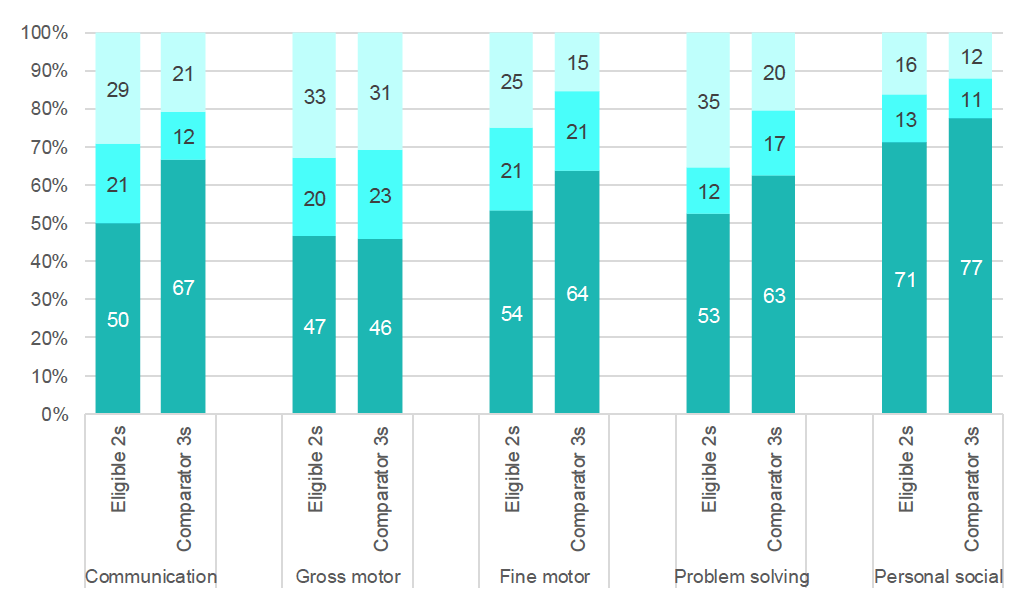
Base: All children (keyworker observations Phase 3, Eligible 2s unweighted, Comparator 3s weighted)
Figure 16: ASQ score by domain, Eligible 2s and Comparator 3s, Phase 3 Description. This stacked column chart shows that on the Communication, Fine Motor, Problem Solving and Personal Social ASQ domains a higher proportion of the Comparator 3s were on schedule compared with the Eligible 2s. In the gross motor 47% of the Eligible 2s and 46% of the Comparator 3s were on schedule.
Differences by gender were slightly more evident for the Eligible 2s than for the Comparator 3s, although they were still present for both groups on all but the gross motor domain. Figure 17 shows that 58% of girls and 42% of boys in the Eligible 2s group, a gap of 16 percentage points, were on schedule for the ASQ communication domain, while 73% of girls and 61% of boys in the Comparator 3s group were on schedule, a gap of 12 percentage points. Figures for the other domains are shown in Appendix C Table C15.
Differences between boys and girls in the proportion on schedule were largest for the fine motor domain: 67% of girls and 40% of boys among the Eligible 2s on schedule, and 75% of girls and 53% of boys on schedule among the Comparator 3s. Girls also outperformed boys on the problem solving and personal-social domains for both groups, while there was no real difference between boys and girls on the gross motor domain for either group.
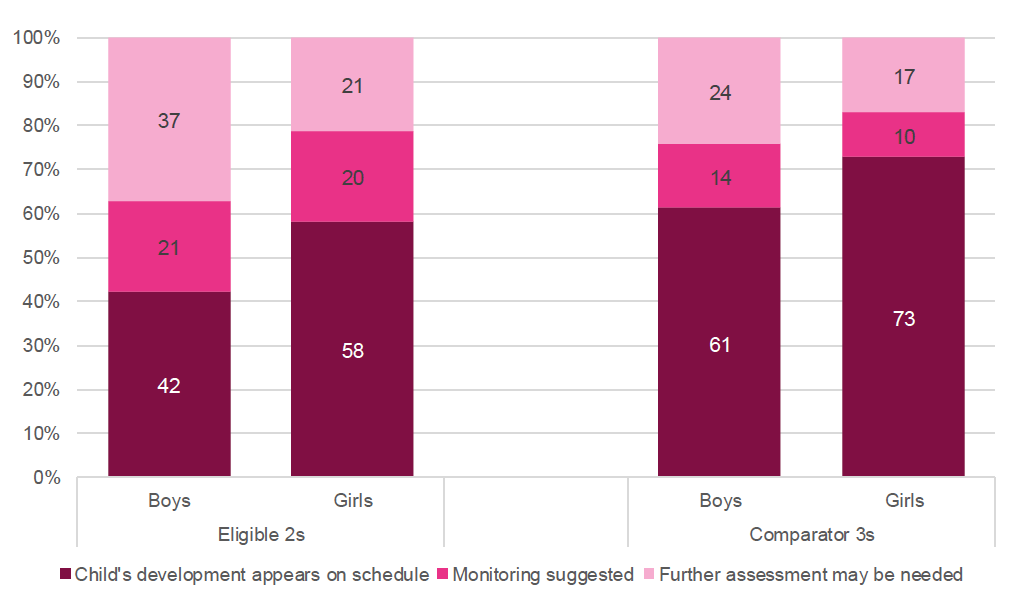
Base: All children (keyworker observations Phase 3, Eligible 2s unweighted, Comparator 3s weighted)
Figure 17: ASQ communication domain by sex, Eligible 2s and Comparator 3s, Phase 3 Description. This stacked column chart shows that 58% of girls and 42% of boys in the Eligible 2s group were on schedule for the ASQ communication domain, while 73% of girls and 61% of boys in the Comparator 3s group were on schedule.
Figure 18 shows the ASQ problem solving domain broken down by area deprivation for both the Eligible 2s and the Comparator 3s. For the Comparator 3s, the proportion on schedule tended to increase with decreasing levels of deprivation, from 54% on schedule in the most deprived 20% of areas to 73% on schedule in the least deprived 40%. The Eligible 2s are more similar to each other in terms of deprivation, so the same pattern was not evident. Differences between the groups on the other domains tended to be smaller for the Eligible 2s than for the Comparator 3s and were not statistically significant for the Comparator 3s on any of them.
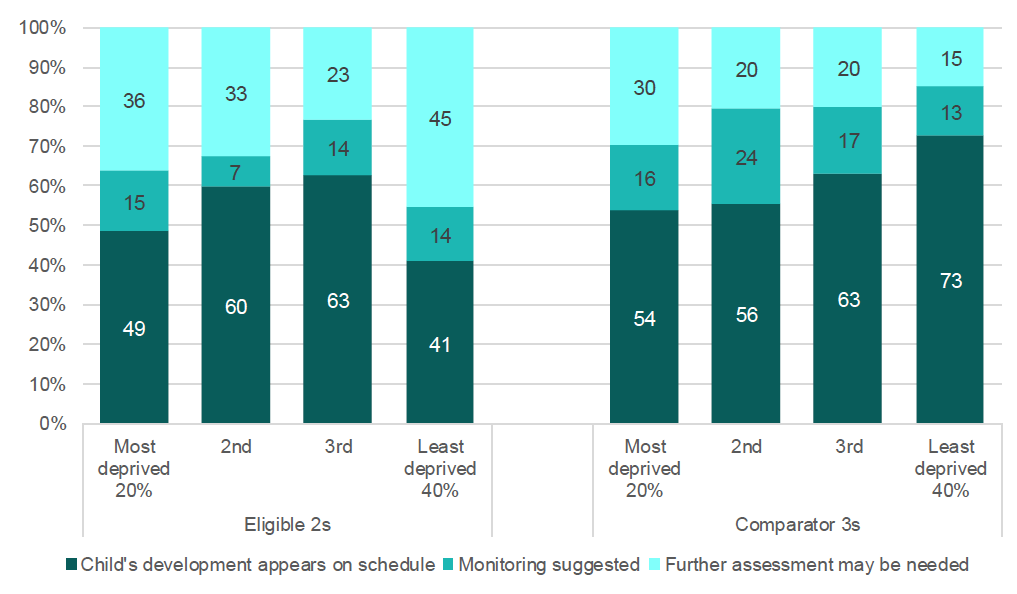
Base: All children (keyworker observations Phase 3, Eligible 2s unweighted, Comparator 3s weighted)
Figure 18: ASQ problem solving domain by SIMD, Eligible 2s and Comparator 3s, Phase 3 Descriptions. This column chart shows the ASQ problem solving domain broken down by area deprivation for the Eligible 2s and the Comparator 3s. For the Comparator 3s, the proportion on schedule tended to increase with decreasing levels of deprivation, from 54% on schedule in the most deprived 20% of areas to 73% on schedule in the least deprived 40%.
Strengths and Difficulties Questionnaire
Figure 19 shows that for the emotional symptoms and prosocial behaviour domains, the differences between the Eligible 2s and the Comparator 3s were very small. Around three quarters of children scored close to average on the emotional symptoms domain (77% of the Eligible 2s and 79% of the Comparator 3s) and on the prosocial behaviour domain (72% of the Eligible 2s and 75% of the Comparator 3s). Differences in the total difficulties score (58% of the Eligible 2s close to average, compared with 66% of the Comparator 3s) were driven by differences in the conduct problems domain (75% of the Eligible 2s and 82% of the Comparator 3s close to average), the hyperactivity domain (53% of the Eligible 2s and 61% of the Comparator 3s) and the peer problems domain (55% of the Eligible 2s and 63% of the Comparator 3s).
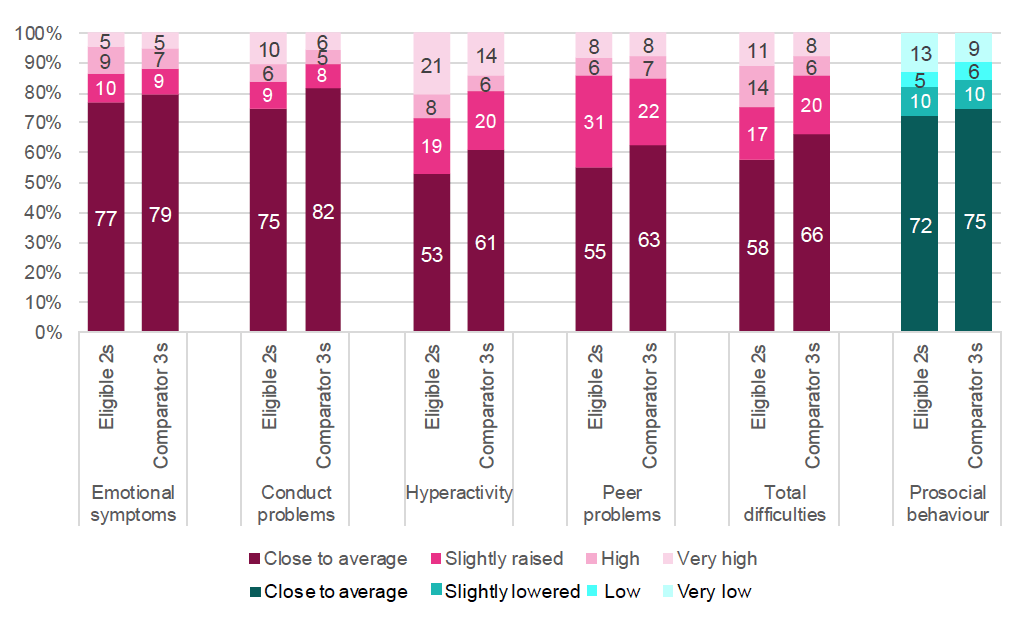
Base: All children (keyworker observations Phase 3, Eligible 2s unweighted, Comparator 3s weighted)
Figure 19: SDQ score by domain, Eligible 2s and Comparator 3s, Phase 3 Description. This stacked column chart shows that on the Conduct Problems, Hyperactivity and Peer Problems SDQ domains, and the SDQ Total Difficulties score a higher proportion of the Comparator 3s were on schedule compared with the Eligible 2s. 77% of the Eligible 2s and 79% of the Comparator 3s scored close to average on the emotional symptoms domain and 72% of the Eligible 2s and 75% of the Comparator 3s on the prosocial behaviour domain.
With the exception of the emotional symptoms domain, the proportion of girls scoring close to average was higher than the proportion of boys for both the Eligible 2s and the Comparator 3s. This is illustrated in Figure 20 for the total difficulties score. Among the Eligible 2s, two thirds (66%) of the girls scored close to average, compared with half of the boys (50%). For the Comparator 3s, these figures were 71% of the girls and 61% of the boys. Table C16 in Appendix C shows the proportions scoring close to average for the individual domains. Differences by area deprivation appeared larger for the Comparator 3s than for the Eligible 2s, but were not statistically significant for any of the domains.
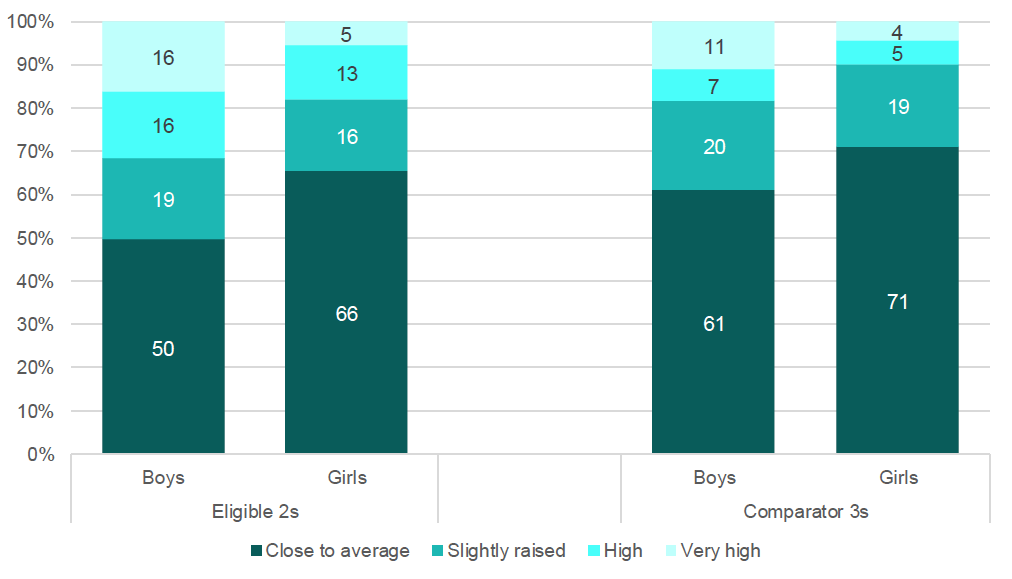
Base: All children (keyworker observations Phase 3, Eligible 2s unweighted, Comparator 3s weighted)
Figure 20: SDQ total difficulties score by sex, Eligible 2s and Comparator 3s, Phase 3 Description. This stacked column chart shows that for Eligible 2s, 66% of the girls scored close to average, compared with 50% of boys. For the Comparator 3s, 71% of the girls scored close to average compared with 61% of the boys.
Given the similar findings demonstrated so far on the ASQ and SDQ measures of child development, it is not surprising to note that there is a strong correlation between the two. However, as Figure 21 also illustrates, there is a clear difference between the measures, with the ASQ combining measures of physical, cognitive and social development, and the SDQ having a more narrow focus on social, emotional and behavioural development. For both the Eligible 2s and the Comparator 3s, around four in five of those who were on schedule for at least four of the ASQ domains scored close to average on the SDQ total difficulties scale (79% of the Eligible 2s and 82% of the Comparator 3s). Much lower proportions of those who were on schedule for no more than three of the ASQ domains scored close to average on the SDQ scale (42% of the Eligible 2s and 49% of the Comparator 3s). This implies firstly that there are a number of children for whom issues are being picked up on both scales. Hence where a physical development problem is observed, it is important to consider whether their may be other developmental problems of a social or emotional nature. It also implies that there a number of children who may be slower in their development in one area, but not in others. It is therefore important to consider a range of measures, as covered by the ASQ and SDQ, to identify potential delays in development, so that children do not miss out on the support they may need in specific areas just because their development is on schedule in others.
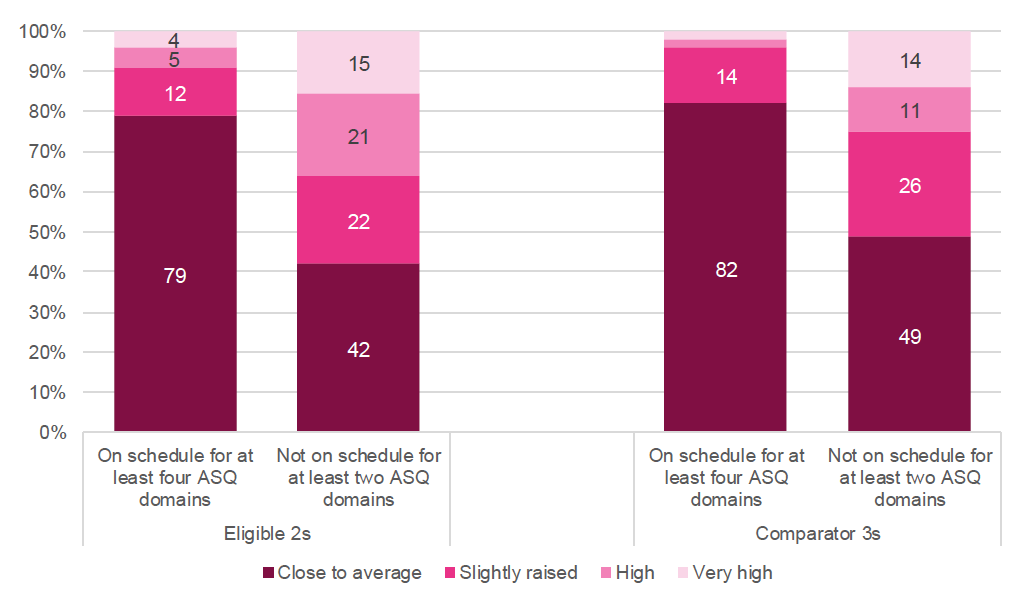
Base: All children (keyworker observations Phase 3, Eligible 2s unweighted, Comparator 3s weighted)
Figure 21: SDQ total difficulties score by whether on schedule for at least 4 ASQ domains, Eligible 2s and Comparator 3s, Phase 3 Description. This stacked column chart shows that 79% of the Eligible 2s and 82% of the Comparator 3s who were on schedule for at least four of the ASQ domains scored close to average on the SDQ total difficulties scale. 42% of the Eligible 2s and 49% of the Comparator 3s who were on schedule for no more than three of the ASQ domains scored close to average on the SDQ scale.
General health
Most children were described as being in good or very good health by their parent or carer, although the proportion was slightly higher for the Comparator 3s than the Eligible 2s (96% and 91% respectively). No significant patterns were observed for either group in terms of health by sex, area deprivation or the type of household in which the child lived.
The proportion of children with a longstanding illness or health condition was higher for the Eligible 2s than for the Comparator 3s: 14% of the Eligible 2s had a longstanding condition (11% had a limiting longstanding condition), compared with 7% of the Comparator 3s (4% a limiting one). This difference was largely due to children receiving discretionary funding from their local authority at age two, 31% of whom had a longstanding illness at age three (22% limiting), compared with 10% of the Eligible 2s who had state funded places (8% limiting). For many of these cases, the longstanding condition was likely to be the reason for providing a funded place.
A quarter (25%) of the parents of the Eligible 2s and one in five (20%) of the parents of the Comparator 3s who had a longstanding condition reported that it affected their child in multiple ways. The most commonly reported way in which children were affected were stamina or breathing difficulties (46% of the Eligible 2s with a condition and 28% of the Comparator 3s).
Parents of the Eligible 2s were more likely than those of the Comparator 3s to mention concerns about how their child talks. A quarter (25%) of the parents of the Eligible 2s mentioned such concerns, compared with one in six (17%) of the parents of the Comparator 3s. For both groups, concerns about what the child understands were mentioned less frequently (12% of the Eligible 2s and 7% of the Comparator 3s). Among the Eligible 2s, concerns about how their child talks were higher for those receiving discretionary funding from their local authority (36%) than those funded through their statutory entitlement (22%). For these cases, speech and development concerns may have been related to the reason for receiving a funded place.
Home environment
Children spend a lot more time at home than they do in nursery each week, so it is important to consider the home environment when discussing their development. The home environment can be very complex, comprising relationships within the household, as well as the physical environment, and we have chosen to look at four different aspects of home life which previous studies have found to be associated with child development: sleeping patterns, breastfeeding, the frequency of undertaking learning activities with an adult, and the general level of order or chaos within the home.
A higher proportion of children in the Eligible 2s group never slept through the night than in the Comparator 3s group (18% and 12% respectively, see Appendix C Table C17). This is reflected in the amount of sleep children get each night, with 19% of the Eligible 2s getting less than 10 hours, compared with 6% of the Comparator 3s (Figure 22).
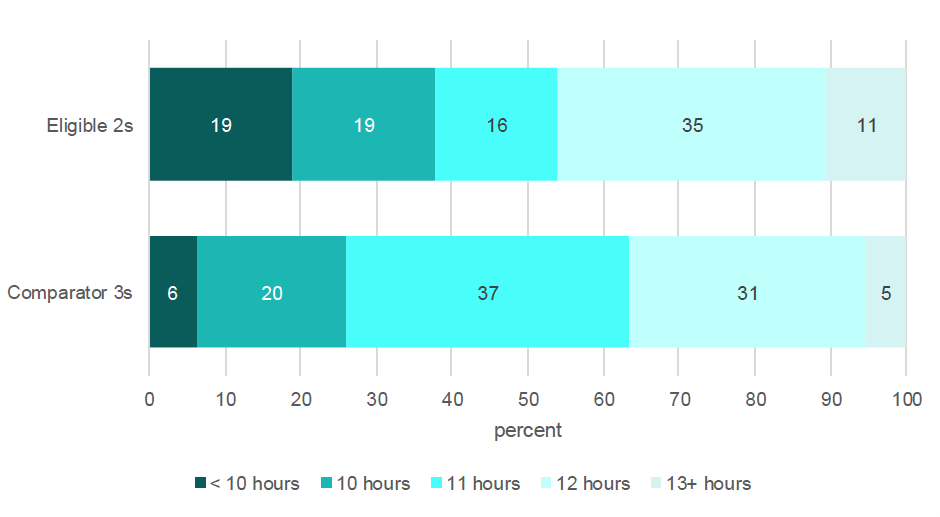
Base: All children (parent questionnaire Phase 3, Eligible 2s unweighted, Comparator 3s weighted)
Figure 22: Hours of sleep per 24 hours, Eligible 2s and Comparator 3s, Phase 3 Description. This stacked bar chart shows that 19% of the Eligible 2s got less than 10 hours sleep per night, compared with 6% of the Comparator 3s.
Breastfeeding was more common among the Comparator 3s than among the Eligible 2s, and within the Comparator 3s it was more common in two parent households than in single parent households, and in less deprived areas. More than half (57%) of the Comparator 3s group were breastfed as babies, compared with just over a third (38%) of the Eligible 2s. Of the Comparator 3s in two parent households, 61% were breastfed, compared with 38% in single parent households. While there was a difference for the Eligible 2s, it was not so stark: 46% of those in two parent households were breastfed, compared with 32% of those in single parent households. In the most deprived areas, there was no difference between the two groups, with a third of each having been breastfed (34% of the Eligible 2s and 33% of the Comparator 3s). However, in the least deprived areas, the Comparator 3s were much more likely to have been breastfed (72% compared with 45% of the Eligible 2s) (see Figure 23).
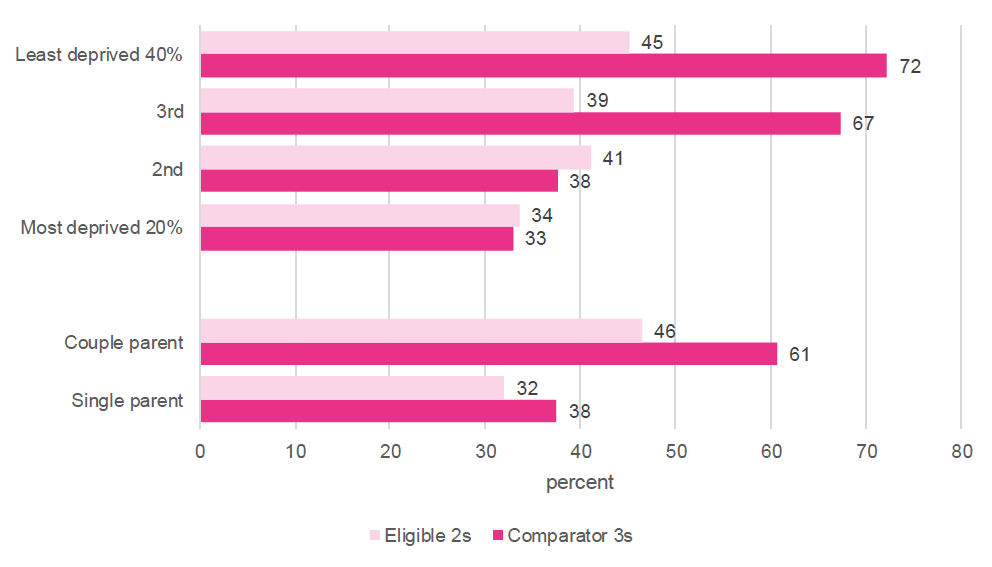
Base: All children (parent questionnaire Phase 3, Eligible 2s unweighted, Comparator 3s weighted)
Figure 23: Whether child was breastfed, Eligible 2s and Comparator 3s, Phase 3 Description. This clustered bar chart shows that in the most deprived areas, 34% of the Eligible 2s and 33% of the Comparator 3s had been breastfed. In the least deprived areas, 72% of the Comparator 3s were have been breastfed compared with 45% of the Eligible 2s. It also shows that of the Comparator 3s, in two parent households, 61% were breastfed, compared with 38% in single parent households.
Table 3 shows the four different activities that make up the home learning environment scale. While it shows some large differences between boys and girls in the frequency of undertaking particular activities at home, it shows few differences between the Eligible 2s and the Comparator 3s. The Comparator 3s were slightly more likely than the Eligible 2s to look at books every day (62% compared with 54%), and girls within the Comparator 3s were also more likely than boys to do the same (68% compared with 56%). A quarter of children in both groups did painting or drawing with someone in their own home every day (25% of the Eligible 2s and 23% of the Comparator 3s). In both groups girls were twice as likely as boys to paint or draw every day (33% of girls and 16% of boys in the Eligible 2s, and 32% of girls and 15% of boys in the Comparator 3s). Nine percent of boys in the Eligible 2s group had done no painting or drawing in the previous 7 days, compared with 2% of girls in that group, and 1% of children in the Comparator 3s. Girls were also more likely than boys to recite nursery rhymes or sing songs every day in both groups (79% of girls and 53% of boys in the Eligible 2s, and 68% of girls and 54% of boys in the Comparator 3s), although there was little difference in the figures for the two groups (66% of the Eligible 2s and 61% of the Comparator 3s). There were no real differences between boys and girls or between the two groups in terms of playing at recognising letters, words, numbers or shapes, with just under half of each group doing so every day (45% of the Eligible 2s and 39% of the Comparator 3s). The frequency of looking at books was associated with area deprivation among the Comparator 3s, with children increasingly likely to look at books every day as levels of deprivation decreased (see Table C18 in Appendix C), although there was no association with area deprivation for any of the other activities.
| Eligible 2s | Comparator 3s | |||||
|---|---|---|---|---|---|---|
| Boys | Girls | All | Boys | Girls | All | |
| % | % | % | % | % | % | |
| Looked at books or read stories | ||||||
| Not in last 7 days | 4 | - | 2 | 0 | - | 0 |
| 1 to 3 days | 22 | 18 | 20 | 18 | 9 | 14 |
| 4 to 6 days | 20 | 27 | 24 | 25 | 23 | 24 |
| 7 days | 54 | 55 | 54 | 56 | 68 | 62 |
| Painting or drawing | ||||||
| Not in last 7 days | 9 | 2 | 6 | 0 | 1 | 1 |
| 1 to 3 days | 43 | 30 | 36 | 48 | 23 | 36 |
| 4 to 6 days | 32 | 36 | 34 | 37 | 44 | 40 |
| 7 days | 16 | 33 | 25 | 15 | 32 | 23 |
| Recited nursery rhymes or sung songs | ||||||
| Not in last 7 days | 5 | 1 | 3 | 2 | - | 1 |
| 1 to 3 days | 18 | 4 | 11 | 11 | 6 | 9 |
| 4 to 6 days | 23 | 16 | 19 | 32 | 26 | 29 |
| 7 days | 53 | 79 | 66 | 54 | 68 | 61 |
| Recognising letters, words, numbers or shapes | ||||||
| Not in last 7 days | 8 | 1 | 5 | 3 | 2 | 2 |
| 1 to 3 days | 24 | 17 | 20 | 28 | 23 | 26 |
| 4 to 6 days | 25 | 34 | 30 | 31 | 34 | 33 |
| 7 days | 42 | 47 | 45 | 38 | 40 | 39 |
| Unweighted base | 130 | 135 | 265 | 284 | 272 | 558 |
Base: All children (parent questionnaire Phase 3, Eligible 2s unweighted, Comparator 3s weighted)
The four activities listed above can be made into a scale from 0 to 28 by summing the number of days on which activity was undertaken in the previous week. This is a useful way of summarising the activities, allowing us to identify the children who engage in home learning activities most frequently. This scale will be used in the next section when we come to look at the associations between the SDQ and ASQ assessments of development and the home environment.
Figure 24 compares responses from parents in both samples on questions designed to measure the level of order within the home. While there were small differences between parents of the Eligible 2s and the Comparator 3s, the vast majority of parents in both groups agreed with the first two items - that first thing in the day they have a regular routine at home, and that the atmosphere in their home is calm - and disagreed with the other two items, that they can't really hear themselves think in their home, and that it's really disorganised in their home. Like the home learning environment, a scale created from summing responses to these four questions[25] will also be used in the next section.
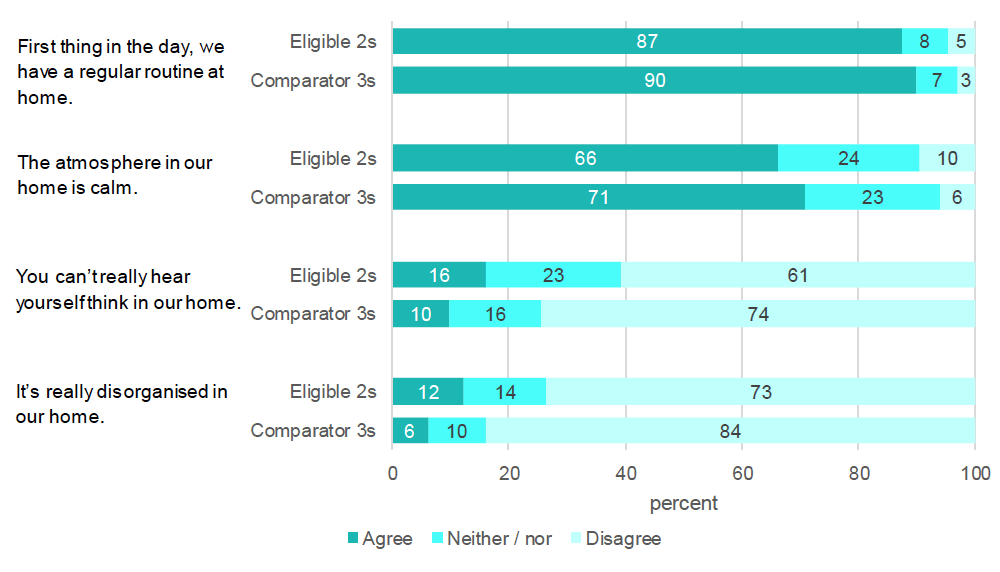
Base: All children (parent questionnaire Phase 3, Eligible 2s unweighted, Comparator 3s weighted)
Figure 24: Items from the Confusion, Hubbub and Order Scale (CHAOS), Eligible 2s and Comparator 3s, Phase 3 Description. This stacked bar chart shows whether parents agreed or disagreed with questions from the Confusion, Hubbub and Order Scale by Eligible 2s and Comparator 3s. The majority of parents in both groups agreed with the first two items - that first thing in the day they have a regular routine at home, and that the atmosphere in their home is calm - and disagreed with the other two items, that they can’t really hear themselves think in their home, and that it’s really disorganised in their home.
Assessments of development and home/nursery environment
In this section we shall look at the associations between children's development and a number of factors characterising the children's home life or childcare arrangements. While we know that a large range of factors are likely to show either positive or negative associations, we shall use logistic regression modelling in order to identify the strongest associations. More details of this technique, including the tables and how to read them, are included in Appendix D.
Two models were constructed for each sample: one to identify factors most strongly associated with being on schedule for at least four of the ASQ domains and one to identify factors most strongly associated with having a close to average SDQ total difficulties score. The first thing to note about both models (Tables D3 to D6 in Appendix D) is that neither are able to explain a great deal of the variation between children[26]. This indicates that child development is very difficult to predict, and that there are a huge number of factors which may influence development, such as genetics or the details of activities and interactions both inside and outside of the home that we were not able to capture in the surveys. The earlier models using longitudinal data for the Eligible 2s had greater predictive power because they included development at age two (Phase 1) as one of the predictor variables. Factors which affected the Phase 1 score, whether they could be measured or not, were still reflected in the Phase 1 score, hence the greater explanatory power of the longitudinal models.
The four models all include whether the child was a boy or a girl, the level of deprivation of the home address, and whether the child had a long-term condition which might affect their development, reported by either the parent or the keyworker. These were not necessarily statistically significant in each of the models, but were included to demonstrate that they had been controlled. All other factors shown in Tables D3 to D6 in Appendix D were statistically significant at the 10% level or lower. A much larger group of factors was tested for inclusion in the models, but the tables as reported include only those that demonstrated a statistically significant association with the outcome once other factors were taken into account. More details, including a full list of the factors that were tested, are included in Appendix D.
Table 4 summarises the two models for being on schedule for at least four of the five domains of the ASQ. It shows that two factors for the Eligible 2s and four factors for the Comparator 3s demonstrated an independent association with being on schedule once other factors were taken into account. For the Eligible 2s, not having a long-term health condition, and being amongst the group who did learning activities at home with an adult most frequently, were the strongest predictors of being on schedule for at least four domains. For the Comparator 3s, the strongest predictor was having a parent with a degree or upper-school or post-school qualifications (such as highers, HNC, etc.). Other marginally significant predictors were being female, speaking English at home as the only or main language, and having a parent with no long-term health condition.
| Statistical significance | ||
|---|---|---|
| Eligible 2s | Comparator 3s | |
| Female | + | |
| No long-term health condition | +++ | |
| English main / only language | + | |
| Highest quartile of the home learning environment scale (most frequent learning activities) | +++ | |
| Parent has degree or upper school qualifications | +++ | |
| Parent has no long-term health condition | + | |
| Unweighted base | 243 | 515 |
Base: All children (with responses to both parent questionnaire and keyworker observations, Phase 3, Eligible 2s unweighted, Comparator 3s weighted)
+++ highly significant, ++ moderately significant, + marginally significant
These associations can be demonstrated through a series of charts – although the figures included in the charts do not control for other factors in the way that the regression analysis allows.
Figure 25 shows that girls were more likely than boys to be on schedule for at least four of the five ASQ domains for both the Eligible 2s and the Comparator 3s (Eligible 2s – 51% of girls on schedule compared with 34% of boys; Comparator 3s – 56% of girls compared with 46% of boys). While Figure 25 clearly demonstrates a large difference for both groups, sex is only significant for the Comparator 3s in the models (Table 4). This is partly due to interactions with other items in the model[27]. The modelling process recognises the home learning environment as a stronger driver of outcomes than being a boy or a girl for the Eligible 2s. As we have seen previously (Table 3) there is a strong association between home learning environment and sex. Once we have accounted for home learning environment, the difference between boys and girls is much smaller.
Figure 25 also shows large differences in the proportion of children on schedule for at least four domains between those with a long-term health condition or illness and those without for both the Eligible 2s and the Comparator 3s. On this occasion, because of the relatively small numbers with long-term conditions among the Comparator 3s, the modelling process did not identify having a long-term condition or not as one of the key drivers for the Comparator 3s, although Figure 25 clearly identifies a difference: 53% of the Comparator 3s and 44% of the Eligible 2s with no long-term condition were on schedule for at least four domains, compared with 36% of the Comparator 3s and 21% of the Eligible 2s with a condition.
Figure 25 also shows small, marginally-significant differences depending on whether English is the main language spoken at home or not[28].
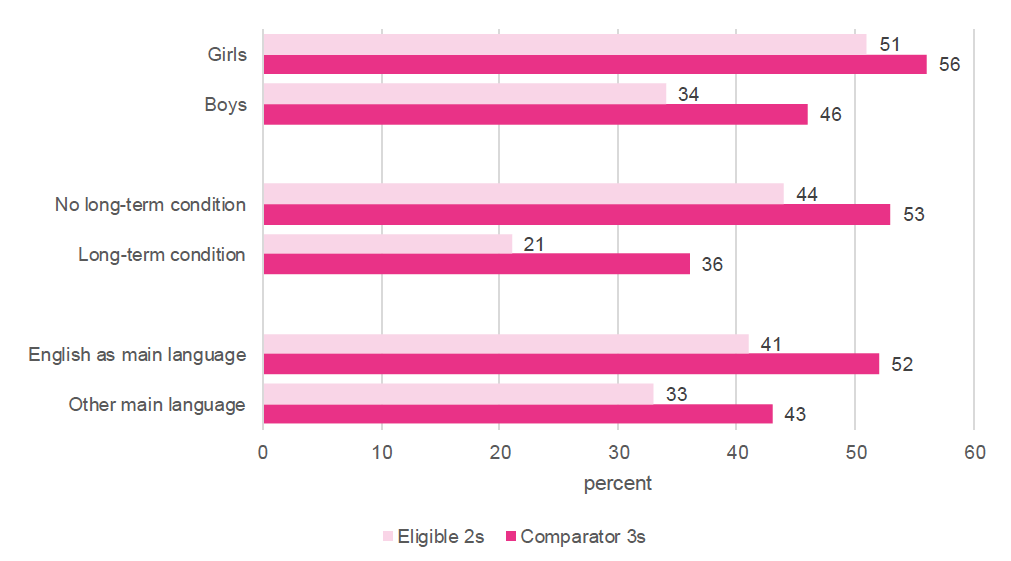
Base: All children (with responses to keyworker observations (girls / boys), and with responses to both parent questionnaire and keyworker observations (long-term conditions and language), Phase 3, Eligible 2s unweighted, Comparator 3s weighted)
Figure 25: On schedule for at least four ASQ domains, by sex, whether child has a long-term condition and whether English is the main language spoken at home, Eligible 2s and Comparator 3s, Phase 3 Description. This clustered bar chart shows the proportion of children who were assessed as on schedule for at least four ASQ domains, broken down by sex, whether child has a long-term condition and whether English is the main language spoken at home, for the Eligible 2s and Comparator 3s.
Figure 26 shows a big difference for the Eligible 2s in the proportion on schedule for at least four of the five ASQ domains between those in the top quartile of the home learning environment scale who undertake the most frequent home learning activities (60%) and the other three quartiles (31 to 37%). There is also significant difference for the Comparator 3s between those in the top two quartiles (59%) and those in the bottom quartile (40%).
For level of parental education, and whether the parent has a long-term condition or not, there is no clear pattern of outcomes for the Eligible 2s, while for the Comparator 3s, there is a large difference in the proportion on schedule for at least four domains between those with a degree (60%) and those with no or only lower school qualifications (31%). Similarly, there is a large difference in the proportion largely on schedule depending on whether the parent has a long-term health condition (36%) or not (55%).
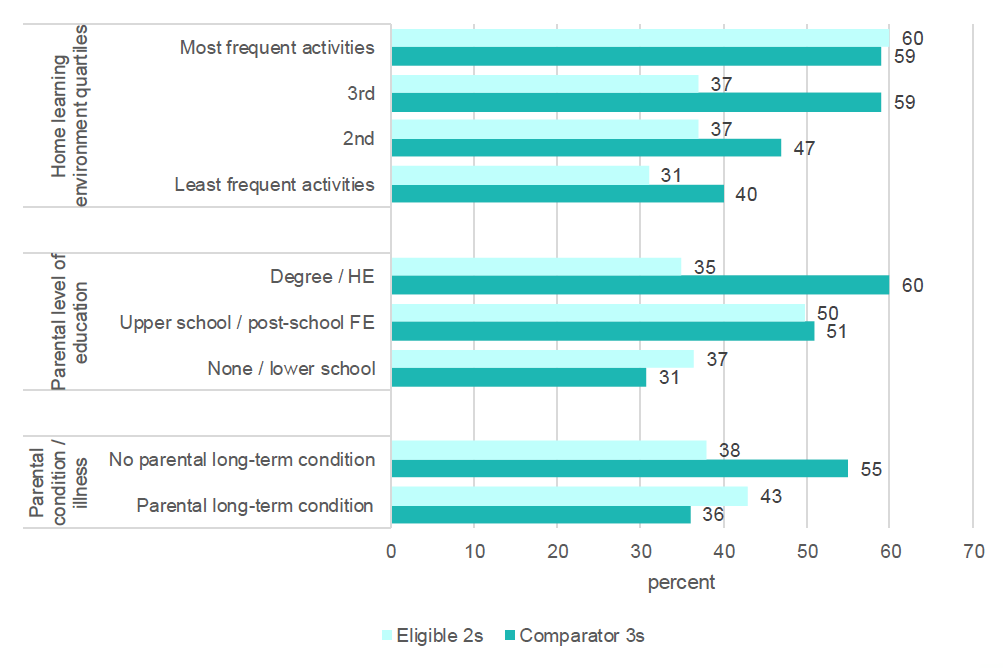
Base: All children (with responses to both parent questionnaire and keyworker observations, Phase 3, Eligible 2s unweighted, Comparator 3s weighted)
Figure 26: On schedule for at least four ASQ domains, by home learning environment, highest level of parental education and whether the respondent has a long-term health condition or illness, Eligible 2s and Comparator 3s, Phase 3 Description. This clustered bar chart shows the proportion of children who were assessed as on schedule for at least four ASQ domains, broken down by home learning environment, highest level of parental education and whether the respondent has a long-term health condition or illness, for the Eligible 2s and Comparator 3s.
The lack of a pattern for the Eligible 2s suggests that the factors which may be associated with low income and lead to their eligibility for funded ELC at age two are not compounding to make outcomes worse for them. This is further evidenced when we note that other factors, such as employment status and area deprivation also showed no clear patterns and showed no association when included in the model. Outcomes for the Eligible 2s, however, may be improved through the interventions that encourage children and parents to take part in activities together, such as those outlined in the home learning environment scale. For the nationally representative Comparator 3s, the large differences depending on level of education, parental illness, and other factors such as income, which only do not appear in the model because of their associations with factors that do, highlights the need for sevices for parents and children which will help close these gaps. The provision of ELC for the Eligible 2s and the increase in provision for all children from the age of three may help reduce these inequalities. The evidence gathered for the next three phases of the Scottish Study of Early Learning and Childcare will help to assess this.
Two further models were run to look at the drivers of having close to average scores on the SDQ total difficulties scale. These are summarised in Table 5, and shown in more detail in Appendix D Tables D5 and D6.
For the Eligible 2s, the model explained almost none of the variation between children. The only marginally significant driver of achieving a close to average score was not having a long-term health condition[29]. A larger sample would likely have helped to identify other drivers of close to average scores, although, as with the ASQ models, it appears that because the Eligible 2s are a more homogenous group in terms of socio-demographics than the Comparator 3s, it is harder to explain the differences in outcomes between children than for the nationally representative Comparator 3s.
For the Comparator 3s, five key drivers of a close to average score were identified: being a girl, living in a non-deprived area, being white, living in an ordered / non-chaotic home, and receiving more than 18 hours a week of childcare, both formal and informal (i.e. more than just the statutory entitlement of ELC). These are explored further in Figures 27 and 28.
| Significance | ||
|---|---|---|
| Eligible 2s | Comparator 3s | |
| Female | ++ | |
| No long-term health condition | + | |
| White ethnic group | ++ | |
| Least deprived 60% of areas | +++ | |
| Most ordered / least chaotic two thirds of homes | ++ | |
| More than 18 hours of childcare (formal and informal) | ++ | |
| Unweighted base | 253 | 518 |
Base: All children (with responses to both parent questionnaire and keyworker observations, Phase 3, Eligible 2s unweighted, Comparator 3s weighted)
+++ highly significant, ++ moderately significant, + marginally significant
Figure 27 shows that girls were more likely than boys to score close to average on the SDQ total difficulties scale among both the Eligible 2s and Comparator 3s: 66% of girls among the Eligible 2s and 71% of girls among the Comparator 3s scored close to average compared with 50% of boys and 61% of boys respectively.
Children with no long-term health condition were more likely to score close to average: 58% of the Eligible 2s and 66% of the Comparator 3s compared with 45% of the Eligible 2s who had a long-term condition and 53% of the Comparator 3s with a condition. Two thirds of children of white ethnic origin among the Comparator 3s achieved close to average compared with 44% of children of non-white origin.
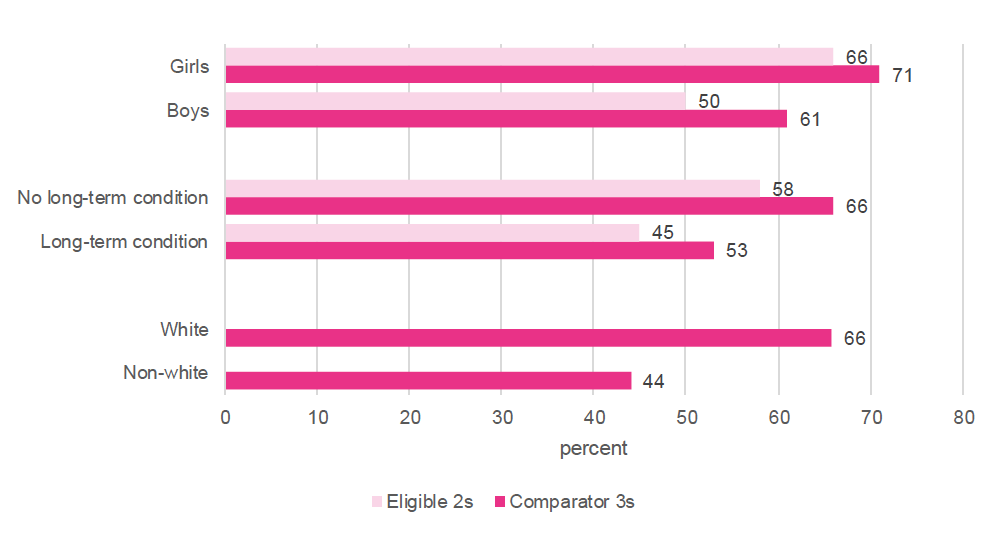
Base: All children (with responses to keyworker observations (girls / boys), and with responses to both parent questionnaire and keyworker observations (long-term conditions and language), Phase 3, Eligible 2s unweighted, Comparator 3s weighted)
Figure 27: Close to average SDQ total difficulties score, by sex, whether child has a long-term condition and ethnicity, Eligible 2s and Comparator 3s, Phase 3 Description. This clustered bar chart shows the proportion of children who were assessed as having a close to average SDQ total difficulties score, broken down by sex, whether child has a long-term condition and ethnicity, for the Eligible 2s and Comparator 3s
Ethnicity not shown for Eligible 2s due to small sample size
Figure 28 shows that among the Comparator 3s, those in the least deprived areas were more likely to be assessed as close to average on the SDQ total difficulties scale: 72% of those in the least deprived two quintiles, compared with 60-62% in the most deprived two quintiles.
For both the Eligible 2s and Comparator 3s, living in a more ordered home was associated with a close to average score: 62% of the Eligible 2s and 68% of the Comparator 3s living in the most well-ordered homes achieved a close to average score on the SDQ total difficulties scale, compared with 50% of the Eligible 2s and 58% of the Comparator 3s living in more disorganised homes[30].
For the Comparator 3s, more than 18 hours a week of childcare was associated with close to average scores. This included the funded ELC placement and any additional formal or informal care. Seventy-one percent of the Comparator 3s receiving more than 18 hours a week childcare were assessed as close to average on the total difficulties scale, compared with 58% of those receiving 18 hours or fewer each week. Whether this translates into better outcomes for children receiving 25 hours or more of funded ELC each week remains to be seen. There was no association between hours of childcare and total difficulties score for the Eligible 2s.
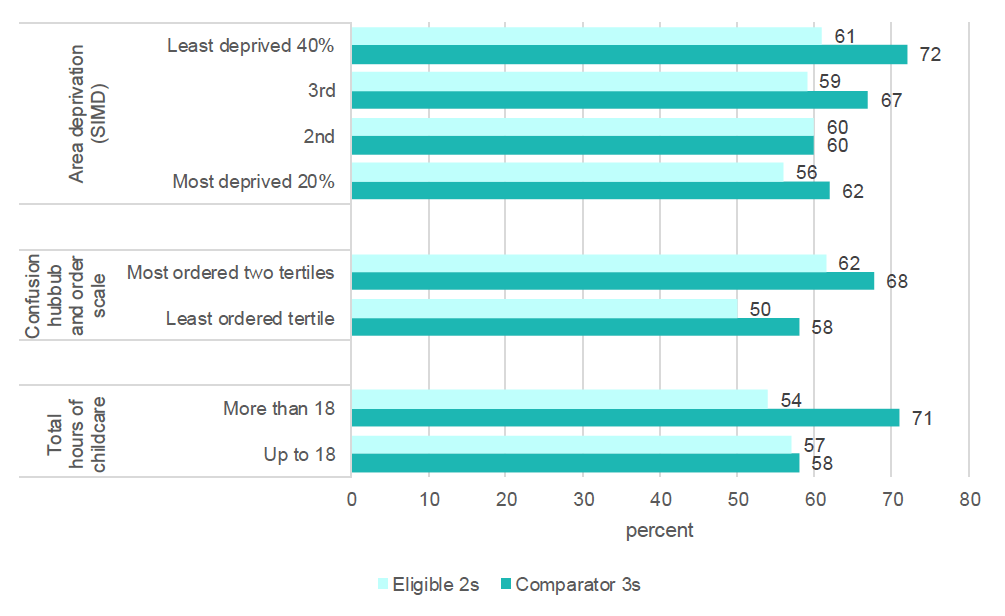
Base: All children (with responses to keyworker observations (SIMD), and with responses to both parent questionnaire and keyworker observations (confusion, hubbub and order scale and hours of childcare), Phase 3, Eligible 2s unweighted, Comparator 3s weighted)
Figure 28: Close to average SDQ total difficulties score, by home learning environment, highest level of parental education and whether the respondent has a long-term health condition or illness, Eligible 2s and Comparator 3s, Phase 3 Description. This clustered bar chart shows the proportion of children who were assessed as having a close to average SDQ total difficulties score, broken down by home learning environment, highest level of parental education and whether the respondent has a long-term health condition or illness, for the Eligible 2s and Comparator 3s
Contact
Email: socialresearch@gov.scot
There is a problem
Thanks for your feedback